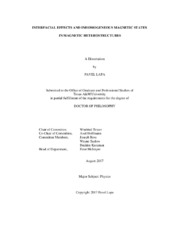| dc.description.abstract | Many interfacial effects occurring in magnetic heterostructures are related to emergence of inhomogeneous magnetic states. In these states, a magnetic order and a direction of magnetization change significantly on the scale of a few nanometers along the thickness of the heterostructures.
This PhD dissertation covers interfacial effects and inhomogeneous magnetic states in three different types of magnetic heterostructures. First, we investigated an unusual exchange bias effect between pinned and unpinned uncompensated magnetization in antiferromagnetic FeMn, which is in proximity with diamagnetic Cu. Using a specially designed antiferromagnet-ferromagnet spin valves, it was shown that even a 110-kOe magnetic field cannot reverse the pinned uncompensated magnetization at the Cu/FeMn interface. The experimental results indicate that the pinning is induced by stress developed in the FeMn/Cu multilayers due to strong thermal contraction of Cu.
Second, we studied magnetic behavior of heterostructures composed of two immensely different ferromagnetic material: rare-earth Gd and permalloy, which are coupled antiferromagnetically. Magnetic field causes an appearance of in-plane domain walls and states in which magnetization is not collinear to a magnetic field. Using a combination of magnetometry and magnetotransport measurements, it was investigated how these inhomogeneous magnetic states evolve at different magnetic fields and temperatures. Fitting experimental dependences to the proposed micromagnetic model allowed obtaining microscopic parameters of the Py/Gd heterostructures. It was also discovered that microdisks composed of the Py/Gd multilayers demonstrate unusual thermal behavior: the microdot magnetization can be transformed from a single domain state to a vortex state in a constant magnetic field by changing the temperature. Moreover, for some temperature ranges, the change in temperature is the only possibility to nucleate the vortex in the disks.
Third, we considered special superconductor/ferromagnet heterostructures, for which, the inhomogeneous magnetic states are constructed artificially to generate odd-triplet superconductivity. It was shown that the suppression of the critical temperature observed for the inhomogeneous magnetic states, which was reported previously by other groups, was not due to the odd-triplet superconductivity. Additionally, kinetic inductance measurements revealed that a slight change in the magnetic field affects the superconducting condensate much stronger than possible generation of the odd-triplet pairing. | en |


